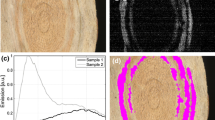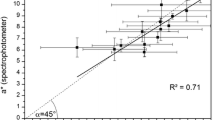Abstract
The research aimed to test the hypothesis that near infrared reflectance (NIR) scans could detect surface characteristics associated with uneven coloring before staining red alder (Alnus rubra Bong), cherry (Prunus sp.), pine (Pinus sp.) and maple (Acer sp.) boards. NIR spectra were successfully correlated with average scanned area data of grain angle, density, pre- and post-staining 8-bit color values, and the difference in color induced by staining when combinations of either three, two or one of the tested wood species were used as input parameters. Difficulties were encountered when both cherry and maple were clustered together with the other two species in a generalized model, however, when both were excluded, the model produced very high R2 values (over 0.98).
Zusammenfassung
Ziel dieser Studie war es, die Hypothese zu überprüfen, dass mittels NIR-Messungen bereits vor der Verfärbung Oberflächenmerkmale von Brettern aus Roterlen- (Alnus rubra Bong), Kirsch- (Prunus sp.), Kiefern- (Pinus sp.) und Ahornholz (Acer sp.) bestimmt werden können, die zu ungleichmäßiger Färbung führen. NIR-Spektren wurden mit über Teilflächen gemittelten Werten von Faserwinkel, Dichte, 8-Bit Farbwerten vor und nach der Färbung sowie dem durch die Färbung erzeugten Farbunterschied bei Verwendung von entweder drei, zwei oder einer der untersuchten Holzarten als Eingabeparameter erfolgreich korreliert. Schwierigkeiten traten auf, wenn sowohl Kirsche als auch Ahorn mit den beiden anderen Holzarten in einem umfassenden Modell zusammengefasst wurden. Wenn jedoch beide ausgeschlossen wurden, ergab das Modell sehr hohe R2-Werte (über 0,98).




Similar content being viewed by others
References
Creative Homeowner Editors (2004) Cabinets, Shelves & Home Storage Solutions: Practical Ideas & Projects for Organizing Your Home
Dorge V, Howlett FC (1998) Painted Wood: History and Conservation. In: Proceeding, The Getty Conservation Institute, Los Angeles
Eastment HT, Krzanowski WJ (1982) Cross-validatory choice of the number of components from a principal component analysis. Technometrics 24:73–77
Flexner B (1999) Understanding wood finishing: how to select and apply the right finish, Chap 5: Staining Wood. Reader’s Digest Association, Inc, Pleasantville, pp 72–188
Gindl W, Teischinger A (2002) The potential of VIS- and NIR-spectroscopy for the non-destructive evaluation of grain-angle in wood. Wood Fiber Sci 34:651–656
Haartveit EY, Flæte PO (2008) Near Infrared Spectroscopy (NIRS) as a Tool for Effective Classification of Wood. In: Proceedings of the 51st International Convention of Society of Wood Science and Technology, November 10–12, Concepción, Chile, paper WS-25 1 of 9
Jewitt J (1999) Great wood finishes: A step-by-step guide to beautiful results. The Taunton Press, Newtown, p 294
Pastore TCM, Braga JWB, Coradin VTR et al (2011) Near infrared spectroscopy (NIRS) as a potential tool for monitoring trade of similar woods: discrimination of true mahogany, cedar, andiroba, and curupix′a. Holzforschung 65(1):73–80
Sandberg K, Sterley M (2009) Separating Norway spruce heartwood and sapwood in dried condition with near-infrared spectroscopy and multivariate data analysis. Eur J Forest Res 128:475–481
Schimleck LR, Evans R (2003) Estimation of air-dry density of increment cores by near infrared spectroscopy. Appita J 56:312–317
Schweingruber FH (2007) Wood structure and environment. Chap 2: Preparation of wood and herb samples. Springer Series in Wood Science, Berlin
Stamm AJ, Hansen LA (1937) The bonding force of cellulose materials for water from specific volume and thermal data. J Phys Chem 41:1007–1016
Tsuchikawa S (2007) A review of recent near infrared research for wood and paper. Appl Spectrosc Rev 42(1):43–71
Tsuchikawa S, Inoue K, Noma J, Hayashi K (2003) Application of near-infrared spectroscopy to wood discrimination. J Wood Sci 49(1):29–35
Via BK, So CL, Shupe TF, Stine M, Groom LH (2005) Ability of near infrared spectroscopy to monitor air-dry density distribution and variation of wood. Wood Fiber Sci 37:394–402
Acknowledgments
This work was financially supported by a research grand provided by the Natural Resources Canada (NRCan), Value-to-Wood program. We also thank Profs Shawn Mansfield and Phil Evans for the NIR spectrometer donation and assistance with the finishing wood properties, respectively. MiCROTEC’s GOLDENEYE specimen scanning and data analysis is greatly appreciated.
Author information
Authors and Affiliations
Corresponding author
Rights and permissions
About this article
Cite this article
Lazarescu, C., Panagiotidis, K. & Avramidis, S. Color variation of stained wood products in association to near infrared spectroscopy scans. Eur. J. Wood Prod. 72, 81–85 (2014). https://doi.org/10.1007/s00107-013-0758-4
Received:
Published:
Issue Date:
DOI: https://doi.org/10.1007/s00107-013-0758-4




